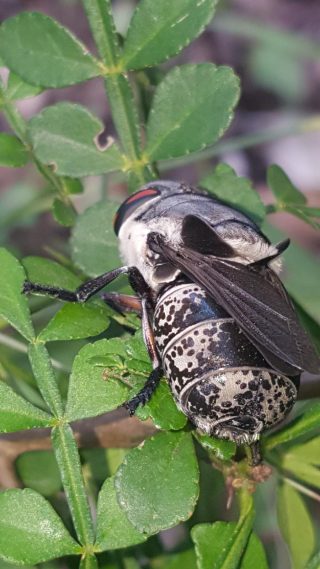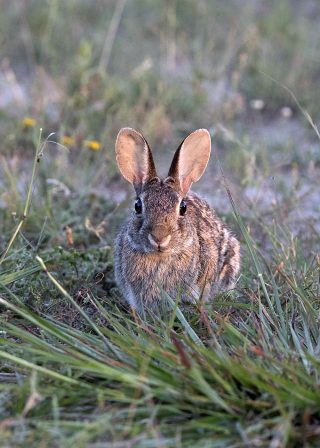11/24/2017 – This Ugly Bug Is Bad News for Rabbits

A Rabbit Bot Fly is an ugly bug that does not bite or sting. However, it lays its eggs near rabbit burrows or scrapes. Rabbits (and other mammals) get the eggs on their fur. The eggs hatch into larvae which embed themselves under the skin of their hosts. Balde & Jaime Galvan photo.
I think I may be the only Master Naturalist in Bee County. There are many others of us naturalists nearby, but here in Beeville, I am the “go-to” person to whom one presents an unknown creature for identification. I am getting better at it as I go along, but there are so many weird bugs, beasts, and plants, that I have to really work at it sometimes. Fortunately, I know when to call in experts to help me out. Such an occasion happened just this past week.
Balde Galvan and his brother Jaime were finishing up a morning’s hunt on their lease in west Bee County. They stopped to pick a few ripe chile petin fruits and on a nearby bush they spotted a weird bug. Balde photographed it and sent the picture to my husband and me. He texted: “What is this? Do you want it?” My husband immediately responded: “Yes, we want it! But we have no idea what it is!”
While the Galvans were driving to our farm, I tried to identify the strange bug. It had six legs, so I knew it was an insect. But that doesn’t tell you much! “With around one million named species and perhaps several times that number unnamed, insects account for the great majority of species on earth.” This is according to animaldiversity.org. Still, it is possible to narrow down the general type of insect by examining its size and basic features. To me this bug looked like a cicada because of its bulging eyes and large (about one inch long) body. So we went to the cicada photos posted on Bugguide.net. Scanning through the dozens of cicada species resulted in no matches. Was it an unknown cicada? Or was it something else?
We looked at the insect the Galvans delivered to us. Up close and personal, it was hideous (I thought). It had a bulging gray and black blotched abdomen, small wings, and large black eyes with a red bar through the middle. We discussed amongst ourselves what it resembled. Jaime thought it looked like a large fly—like a horsefly on steroids!
Ever since I saw the movie The Fly (1986) I have been squeamish about overly large (mansize?) flies. Our new bug brought back my old feeling of revulsion. (Those bristles growing out of Jeff Goldblum’s back—horrible!!!) But I had to admit that this bug did have fly-like features.
It was time to submit the photo to Bugguide.net and see what the experts thought. Not long after sending in the photo, we received a reply. They identified it as a Rabbit Bot Fly (Cuterebra buccata). Another website, www.InsectIdentification.org, writes: “The Rabbit Bot Fly does not bite. It does not sting. Adults …focus solely on reproduction. It is the larval form (maggot) of the species that gets all the attention.”
This is where it gets really gross. Rabbit Bot Flies lay their eggs around the edges of a rabbit’s burrow. Any rabbit (or other mammal) passing by can pick up the eggs on its fur. The egg migrates to an area just under the skin of the host. It hatches and grows into a parasitic maggot that forms a lump. The lump is called a “warble.” Two breathing tubes extend from the larva out of a small hole (called a “warble hole”) on the lump. It feeds on the host’s body fluids and causes considerable irritation and swelling. The maggot gets to be big, about an inch long, before it squeezes out of the lump to encase itself and pupate in the ground.

This cottontail is oblivious to the bot fly eggs in the grass around her burrow. If she makes contact with them, the resulting larvae will produce “warbles” (lumps) on her body. Robert Benson photo.
In wild animals, bot flies are bad news. These animals must just live with the parasite until it exits on its own. Unfortunately, it leaves behind a sizable cavity in the host’s skin, which is prone to infection, and is slow to heal.
However, domestic animals are luckier. If we notice one of our pets or livestock animals has a warble lump, we usually seek a veterinarian’s help. The vet puts Vaseline or dilute Clorox on the larva’s breathing tubes, causing it to extend itself out of the hole a little bit. Then, the vet pulls the maggot out with tweezers. The warble hole is cleaned and treated with antibiotic to help it heal properly.
Just another day in the life of a vet, I guess. But the YouTube videos show even the veterinarians looking disgusted during bot fly removal. I can’t say I blame them. It is not a pretty sight. Do not, I repeat, DO NOT LOOK at the YouTube videos posted showing the extraction of bot fly larvae! You will be very sorry if you do.
Column by Karen L. P. Benson
